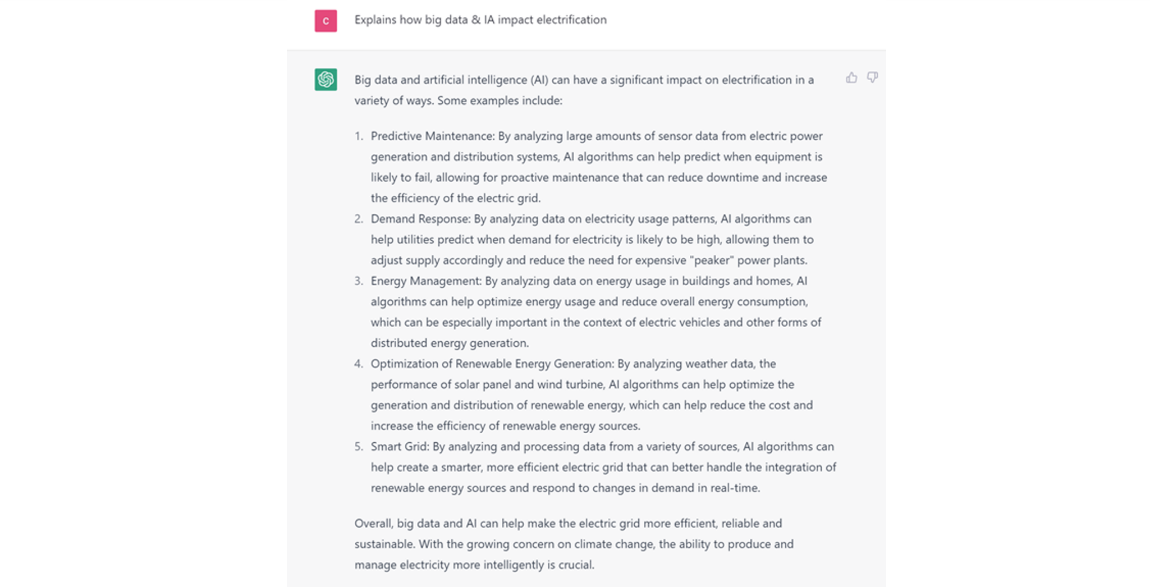- Markets
- Catalogue
- Services
- Tools & Resources
- Downloads
- Company
- Newsroom
-
Nexans Insights
- Nexans Insights
-
Blog Posts
- Overview
- Growing demand for copper and its future
- Electromobility: the road to building an increasingly sustainable transport system
- Guide to Prevent Fires and Accidents at Home (only in Spanish)
- Ten technologies to electrify the future: Electrical and Fire Safety
- Big data & AI
- IoT
- Unveiling innovations transforming the industry
- Transforming buildings industry with 3D printing and modular construction
- The path to effective fire safety in buildings
- Powering the digital change
- Unleashing the power of DC buildings
- Sustainable buildings for a brighter future
- Industry 1, 2, 3, 4... and 5.0
- Nexans copper odyssey
- Limitations of aluminium as an electrical conductor in residential installations
- Find Distributors
- Search
- Contact us
- Compare
- Sign in
Ten new technologies to electrify the future: Big data & AI


Artificial Intelligence has been around for a while. The first models date back to the 70s but these concepts remained theoretical until we were actually able to teach computers to think for themselves. Today, Artificial Intelligence is everywhere. It allows computers and cloud connected devices to reproduce human-related behaviours such as reasoning, planning and creativity. Artificial Intelligence is primarily dependent on the quantity of data it is given. This is where big data plays an active role. With the increased collection and analysis of digital data, big data and AI are now emerging as rich areas of opportunity for electrification professionals.
Electricity 4.0 : Big data and AI for smarter power management
Big data is a major trend in the energy industry. The Electrical network become smart grid due to Data collected from a variety of sources, such as smart meters, sensors, twin digital. Once stored, this data is an invaluable resource for the industry to make better decisions about energy production and consumption.
Electricity was deployed extensively in the late 19th century, which was the First Wave of Electrification from 1880 to 1920. This period saw the widespread adoption of electrical power in industry and the development of the first electrical grid. Then the Second Wave of Electrification took place between 1920 and 1950 with the expansion of the electrical grid into homes and the development of new electrical appliances such as refrigerators, washing machines… During the third wave of Electrification from 1980 to present, we have seen the growth of the digital revolution and the development of new technologies such as computers, the Internet, and mobile phones.
Today the fourth wave of electrification so-called Electricity 4.0 is characterized by the integration of digital technologies such as Artificial Intelligence (AI), the Internet of Things (IoT), and advanced data analytics into the electricity infrastructure.
The aim of Electricity 4.0 is to create a smarter, more efficient, and more sustainable electricity system that can respond to the fast changing demands (+20% by 2030, +40% by 2040).
Electricity 4.0 is expected to optimize the use of existing assets, integrate renewable energy sources into the grid, increase energy efficiency, reduce greenhouse gas emissions, improve grid stability, reduce costs for customers and provide more reliable and flexible energy services to customers.
Moreover, generative AI and adjacent models are changing the game. Indeed, support technology reaches a new level, application development time is reduced, and powerful capabilities are brought to non-technical users.
Just recently, we saw the buzz around ChatGPT and what it can achieve. For instance, if we ask the question “how do big data and AI impact electrification”, we have to admit ChatGPT answer might not be perfect but is still very impressive.

These technologies will definitely have an impact on the world of electrification. But AI is mainly dependent on the quantity and quality of the data that will be used to learn. Big data provides the storage and processing capabilities necessary to educate the AI by feeding it with a lot of information.
Machine Learning and AI are the winning combo to efficiently exploit big data. This involves identifying patterns via data mining and data science more generally.
Big data: The cloud has won
In the age of big data, the famous wave 2 of "move to cloud" announced by providers is underway and is accelerating. As a reminder, the first phase of a migration to the cloud is a discovery phase that allows to analyze the strengths and weaknesses of an infrastructure and to determine future needs.
The number of detractors is getting smaller every day, privacy and sovereignty issues are both solved by the strategic commitments of clouders and swept away by the ease of use... All sectors - banking, telecoms, insurance, etc. - are rapidly adopting cloud-hosted big data solutions.
The first paradigm shifts are appearing in the world of electrification, driven in particular by operators such as Total Energie or Schneider. We can also note the predominance of the estimated Azure services of Microsoft Vs Aws of Amazon in the field of public cloud related to big data.
Exploring the challenges of generative IA and big data in 2023
Generative IA promises to make 2023 one of the most exciting years for IA, and by extension, big data!
It should be noted that ChatGPT's prowess is based on the network registered in 2021, however, as with any new technology, one must always act with pragmatism and restraint, since technology currently presents many challenges:
- Ethics: What sovereignty exists for the data? What protection do personal data have? What commitment to transparency and legibility do the actors offer?
- Environment: AI and big data are a paradox as they represent both a solution to optimize energy consumption and resource mobilization and a cause of this increase.
- Cybersecurity: AI and big data in the field of energy are mainly based on measuring instruments, therefore on the Internet of Things, and offer an ever-increasing security surface.
- Business model: If the value of IA in the field of energy can no longer be demonstrated, the business model associated with services is very complex. For example, in the residential segment, the ChatGP virtual assistant has caused a stir just like Amazon due to the announcement of a massive layoff, including the division of Alexa (Amazon's virtual assistant), in the same week
- Talents: The development of digital services requires the incorporation of excellent technical skills; although not only the entire operating model needs to be rebuilt. The human dimension is one of the biggest challenges brought by IA and big data: attraction, sense of work, conditions, etc.
Big data analytics combined with artificial intelligence also carries several risks. Major concerns include unintended consequences of automated decision making, increased risk of cyberattacks due to reliance on technology, inaccurate predictions leading to bad decisions, over-reliance on algorithms instead of human judgment, lack of transparency in the development process, etc.
IA and big data for Nexans
As noted above, IA in the energy sector is frequently developed through a physical-digital system, i.e. software + hardware.
In this sense, an important part of our work in terms of AI and big data corresponds to the application of learning based on neural networks. The role of the latter is to translate images or texts of measuring instruments (thermometers, drones, etc.) into numbers. The goal of this approach is to understand recurrences, date them, predict them, and locate them. We are in the age of IA for network monitoring.
One of the important activities in the field of electrification is the monitoring of networks for all segments: generation, transmission, distribution and use of electrical energy in buildings and industries. This requires the production and application of sensors that measure electrical activity throughout the value chain.
In developed economies, this scenario is already possible thanks to smart meters for homes or industries. Likewise, the temperature and voltage of the high-voltage transmission lines are systematically controlled. Medium voltage electricity distribution networks and distributed renewable energy connection networks are monitored to a lesser extent. Therefore, it is essential to obtain data from the entire electricity distribution chain.
A second important activity is data analysis to optimize products or systems, which is the essence of artificial intelligence and big data.
In technical terms, the methods developed essentially for the field of natural language processing are transferred to recurrent neural networks and, more specifically, convolutional neural networks. In other words, the technology stacks of ChatGPT and DALL-E.
Long term energy transitions
Big data is a hot topic with huge implications for the energy sector. It represents a powerful tool that can be used to improve the efficiency of energy systems, production and consumption. In addition, it can serve to improve electrical networks and smart technology.
Thanks to big data, it is possible to explore various scenarios and objectives related to the energy transition. In particular, this technology makes it possible to analyze how different supply systems and sources are interconnected and how they could be optimized in the long term. Therefore, it offers an invaluable perspective to achieve some autonomy in a long-term energy transition objective.
The 3S approach (smart data, reduced data, selectivity) represents a challenge for the coming years. Approached in a haphazard way today, they will become the real challenges for AI applications tomorrow:
- Smart data: Understand and monitor local ecosystems
- Reduced data: Limit the use of big data that consumes a lot of energy
- Selectivity: Optimize the necessary resources (services currently marketed with our solution "Electrical asset")
Our websites
Select your country to find our products and solutions
-
Africa
- Africa
- Ghana
- Ivory Coast
- Morocco
- North West Africa
- Americas
- Asia
- Europe
- Oceania